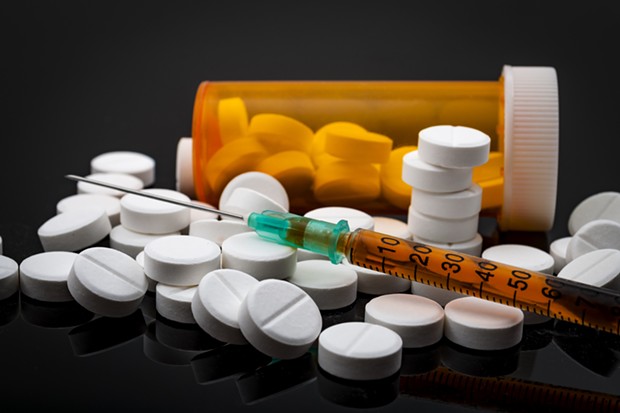Maia Szalavitz was addicted to cocaine and heroin from age 17 to 23. In college, at Columbia University, she says, she sold drugs to make more friends. Things came to a head when she was expelled after the police paid her a visit.
"I opened the door with a needle in my arm," Szalavitz says. "I was expecting a friend."
But being expelled and facing legal consequences for dealing drugs only made her addiction worse. And traditional treatment programs didn't help her.
"Though I knew it was completely wrong, the only thing I could think of to manage my life was more drugs," Szalavitz says.
Szalavitz was among the speakers at a conference hosted by Allegheny Health Network last week, at Allegheny General Hospital. The conference was centered around combating the opioid crisis and featured national experts and AHN addiction-medicine specialists.
“Persons with substance use disorders often face profound stigma and misunderstanding throughout their recovery journey,” said Stuart Fisk, director of AHN’s Center for Inclusion Health, in a statement. The conference, he said, “aims to arm the community with a better understanding about substance use disorders, as well as share innovative, evidence-based approaches to treatment for these and other health conditions that can be applied across the health care spectrum.”
According to the U.S. Drug Enforcement Administration, more than 4,600 Pennsylvanians died from a drug-related overdose in 2016. In 85 percent of drug-related overdose deaths that year, the presence of an opioid, either illicit or prescribed by a doctor, was identified.
Szalavitz is the author of New York Times best-seller Unbroken Brain: A Revolutionary New Way of Understanding Addiction. At the conference she used her experience with addiction to explore misconceptions around addiction and treatment.
Usually, addiction treatment falls into two categories. There's the "moral model," where addiction is defined as a bad choice involving deliberate misbehavior that only punishment can stop. Then there's the "brain disease" model, which views addiction as a chronic, progressive illness that is not a choice. But neither of these models tells the whole story, Szalavitz says.
"The people who see disease fail to realize that it's not automatic. Brain disease insinuates that people don't have choices," Szalavitz says. "And it turns out that all kinds of traits can raise your risk of addiction."
According to studies, 14 percent to 18 percent of people with addiction have anti-social personality disorder. But only 50 percent of addicts have another mental illness. And Szalavitz is part of another segment of addicts, those on the autism spectrum.
Instead of a brain disease, Szalavitz sees addiction as a learning disorder, and says it usually begins during sensitive periods of brain development. She found that 90 percent of all addictions start when people are in their teens and early 20s. And only 20 percent of people who try the hardest drugs become addicted.
"I'm not saying everyone over 30 can go out and try heroin today," Szalavitz says. "I'm saying your risk is lower."
Experiencing trauma before the age of 15 is also a risk factor, and doubles the chance of a person developing a substance-use disorder, Szalavitz says.
But overall, Szalavitz says, substance-abuse disorder is characterized by "continued use, despite persistent or recurring social or interpersonal problems caused or made worse by substance abuse." For this reason, she says, punishment is not an effective means of addressing addiction.
"Punishment cannot fight a disease that is marked by its resistance to punishment," Szalavitz says.
Instead, Szalavitz advocates for a treatment that combines both behavioral therapy and medication, where addicts are given medicine that treats their opioid dependence. However, there remains a lot of stigma around the use of medication-assisted treatment because some view it as replacing one drug with another. Still, Szalavitz says medications like methadone and buprenorphine have cut the death rate for addicts by 50 percent.
"If you had cancer and there was one treatment that did nothing and another that cut the death rate by 50 percent, which one would you chose?" Szalavitz says.
Other speakers, including Josiah Rich, a Brown University researcher, echoed Szalavitz's support for medication-assisted treatment. Rich has spent time assessing Rhode Island’s medication-assisted treatment program and saw positive results. He said there was a 12 percent drop statewide in overdose deaths there.
"We're hoping to use this data to really drive change and practices," Rich said. "There's this mindset that you're not really clean, but these medications are extremely powerful."
By way of comparison, Rich posed the example of a person with diabetes who takes insulin. Sometimes people with diabetes can stop taking insulin due to diet and exercise, but that is not the case for many and doctors still prescribe insulin for these patients.
"The risks are extremely high if you take them off medicine," Rich said. "We really have to push back against this idea that abstinence is the only way."
This year, AHN opened the Center of Excellence for Opioid Use Disorder. Through the center, patients identified as having an opioid-use disorder who request treatment are referred to medication-assisted treatment, outpatient therapy, or inpatient, residential or intensive outpatient programs. To date, the Center of Excellence has served nearly 250 patients.


